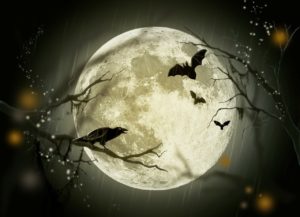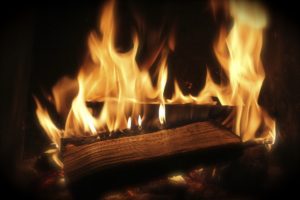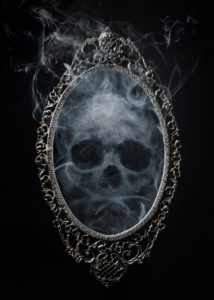 Happy Halloween, everyone! In the spirit of the day, I’m dusting off a post from the archives. I hope you enjoy! 🙂
Happy Halloween, everyone! In the spirit of the day, I’m dusting off a post from the archives. I hope you enjoy! 🙂
When most of us think of Halloween, we tend to envision ghosts and witches and mummies and things that go bump in the night. But did you know that there is actually a history of prophecy (and dare I say romance) associated with the holiday?
Halloween (or Hallowe’en) is essentially a contraction of “hallowed evening,” which was previously known to early Europeans as “All Hallows’ Eve.” The word “hallows” translates to “saint” or “holy person,” and All Hallows’ Eve (October 31st) and All Saints’ Day (November 1st) both paid homage to saints.
Many scholars believe that Halloween as we know it today has its roots in the ancient Celtic festival of Samhain (pronounced sow-win). The Celts, who lived 2,000 years ago, mostly in the area that is now Ireland, the United Kingdom, and northern France, celebrated their new year on November 1st. The date marked the end of summer and the harvest and the beginning of winter. Celts believed that on the night before the new year, the boundary between the worlds of the living and the dead became blurred. On the night of October 31st they celebrated Samhain, when it was believed that the ghosts of the dead returned to earth. As part of their celebrations they would build bonfires and villagers would wear costumes of animal heads and skins.
As the years went by, people in England and Ireland continued to associate that time of year with the wandering dead, often setting out gifts of food to please the spirits. They would also dress in scary costumes in exchange for treats for themselves — a practice called “mumming,” which is similar to today’s trick-or-treating.
However, several of the ancient rituals associated with Halloween actually focused on the future instead of the past and the living instead of the dead. Some of these customs originated as divination rituals, or fortune-telling, and many of them had to do with helping young men and women identify their future spouses. Apples and hazelnuts were commonly used, as in Celtic mythology, apples were strongly associated with the otherworld and immortality, while hazelnuts were associated with divine wisdom.
The following activities were commonly featured in Halloween celebrations in Ireland and Britain during the 17th–20th centuries:
In 18th-century Ireland, cooks would often bury a ring in their mashed potatoes on Halloween night, hoping to bring true love to the diner who found it. In Ireland and Scotland, items would be hidden in food – usually a cake, barmbrack, cranachan, champ or colcannon – and portions of it served out at random. A person’s future would be foretold by the item they happened to find; for example, a ring meant marriage and a coin meant wealth.
Young women were told to peel an apple in one long strip, then toss the peel over the shoulder. The peel was believed to land in the shape of the first letter of their future husband’s name.
Another tale had it that if a young woman ate a sugary concoction made out of walnuts, hazelnuts, and nutmeg before bed on Halloween night she would dream about her future husband.
In Scotland, fortune-tellers recommended that an eligible young woman name a hazelnut for each of her suitors and then toss the nuts into the fireplace. The nut that burned to ashes rather than popping or exploding represented the girl’s future husband. (In some versions of this legend, the opposite was true: The nut that burned away symbolized a love that would not last.)
Another ritual involved two hazelnuts being roasted near an open fire; one named for the person roasting them and the other for the person they desired. If the nuts jumped away from the heat, it was a bad sign, but if the nuts roasted quietly, it foretold a good match.
There are also reports of fortune-cookie-like favors being given out during earlier times. People wrote messages on pieces of paper in milk, and the notes were then folded and placed into walnut shells. The shells would be heated over a fire, causing the milk to brown just enough for the message to mystically appear on the paper for the recipient.
In some villages, a salty oatmeal bannock would be baked. The person would eat it in three bites and then go to bed in silence without anything to drink. This is said to result in a dream in which their future spouse offers them a drink to quench their thirst.
Unmarried women were also told that if they sat in a darkened room and gazed into a mirror on Halloween night, the face of their future husband would appear in the glass. However, if they were to die before marriage, a skull would appear instead.
Other activities were more competitive. At some Halloween parties, the first guest to find a burr on a chestnut-hunt would be the first to marry. At others, the first successful apple-bobber would be the first down the aisle.
Interestingly, most of these traditions have fallen by the wayside as the years have gone by… But this Halloween, while you’re bobbing for apples and enjoying that Snickers bar, remember: It’s a great day to focus on love. 🙂
Wishing everyone a happy, healthy, and safe Halloween!
Until next time.
JA

3 comments
Thanks so much for this history of Hallowe’en!!! Fascinating details!!!
My Anglican church in the San Diego area still calls Halloween “All Hallows Eve”; in fact, we had an All Hallows Eve Party after church on Sunday. In the Anglican tradition, celebrating a holy day/holiday begins at sunset the evening before the actual day being celebrated.
Not to mix holy days/holidays, but this tradition is best seen in the Anglican tradition of celebrating the First Evensong of Easter on the evening before Easter after the Holy Saturday Vigil service that starts at sunset. We process into the church holding candles and celebrate by candlelight the oldest service in the Anglican Church, parts of which date back to the fifth century. Afterward, we sing the First Evensong of Easter (which lasts fifty days) and enjoy sherry and sweets and other items we gave up for Lent as it is now Eastertide!!
Wishing everyone a safe and blessed All Hallows Eve and All Saints Day!!
Very interesting !! Thank you for sharing with us.
Fascinating! The many rituals and superstitions around marriage make me think about how little control people felt (feel?) over the future of their own happiness. Perhaps Charlotte Lucas threw an apple peel over her shoulder, saw the letter C (or W) and decided, “What the hell! Marriage is entirely a matter of chance, after all…” 🙂
Hope you had a great Halloween, Jennifer!